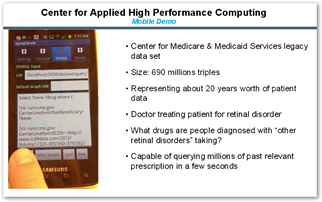This could be good and get a large number of appeals, which are slated to be around 800,000 out of the way, that is if the hospitals agree to the proposed numbers of around 2/3rds of the dollar amounts. It could be small amounts for some hospitals and very large amounts for others. CMS is basically offering to pay a flat amount and be done with it. These are some of the appeals that were a result of audits conducted by contractors at hospitals all over the US in their pursuit of looking for fraud. Stuff like this goes on forever when numbers and cases are reconstructed years after the fact. Many of the RAC auditors are actually subsidiaries of insurance companies as well that provide such audits. It does make you wonder how good the auditing is when in fact you see insurers with their own internal problems such as this one that emerged in New York earlier this year to where over $170,000 was paid for a hammer toe procedure. It just makes you ask about how accurate at these auditing algorithms if you will.
$175,098.80 To Fix A Hammer Toe Billed by New York Podiatrist And the Insurer Paid It, Well Sort Of As They Sent the Check to the Patient By Accident, A New Investigation For “Out of Network” Charges Has Resulted
This is interesting as it was “quietly” posted as the New York Times mentions here. Again it will be up to the hospitals to decide if the settlement works for them and in so many of these appeals, the hospitals have been winning anyway so it’s a matter of if 2/3rds is enough to wipe it out or are the hospitals going to hang in for the full amounts. I said a while back that most of the auditing functions with RAC auditors are not really necessary any longer as CMS is now using fraud detecting software that catches a lot of the known patterns up front and in actuality does send auditors where they should be looking rather than just a random audit of billing practices. Of course the RAC auditors don’t want to lose their jobs either and thus there’s the tug and pull and if it is subsidiary of an insurance company, there’s a lot of a revenue stream with the audits.
and thus there’s the tug and pull and if it is subsidiary of an insurance company, there’s a lot of a revenue stream with the audits.
Here’s Some Folks That Can Be replaced With Technology-Medicare Recovery Audit Contractors - CMS Yarcdata Urika Appliance Can Do This Job And Is With Finding Fraud Patterns…
“The YarcData unit is helping the U.S. government detect fraud patterns in Medicare and Medicaid payments. Private sector customers include medical research group Mayo Clinic and several financial services, life sciences and telecommunications firms, which Cray cannot name for contractual reasons.”
Due to today’s complexities and the old audit methodologies no longer containing high levels of accuracy, we are kind of spinning our wheels here with kind of a “he said she said” scenario that wastes everyone’s time.
A good example of trying to rebuilt an audit situation was the VA and I called “foul” on this one myself as quantitating numbers is not going to change the fact that patients died but when you look at what’s put out there today, there’s a lot of this going on and you can get sucked in easy enough, we all do at times. People are using quantitated math functionality to change virtual values that impact “what really happens in the real world”, which is very dangerous indeed, and the balance is very skewed at times when there’s money involved.
VA Inspector General Takes the “Virtual Low Road” With Report at Phoenix Hospital, Working Some Quantitated Mathematical Justifications But We All Know In the “Real” World People Died…
Medicare Penalties for Hospitals To Take Effect Later This Year With Patient Safety - Can We Learn From the VA On Not Being “Stat Rats” And Attain The “Desired virtual Numbers” In The “Real World”?
So again hospitals, depending on their number of appeals and dollar amounts will have to make their own decisions and I would imagine there could be quite a few takers on this as it represents one less headache of bean counters in the virtual/real world confusion we live in today which I call “The Grays”, a very big problem indeed.
decisions and I would imagine there could be quite a few takers on this as it represents one less headache of bean counters in the virtual/real world confusion we live in today which I call “The Grays”, a very big problem indeed.
Virtual Worlds, Real World We Have A Problem And It’s A Big One With A Lot of Gray Areas Finding Where The Defining Lines Exist, Confusing Many With A Lot of Weird Values And Strange Perceptions…
100 Bottles of Beer, watch this short video and it pretty much explains what’s going on here with how some of this works and the fact that variables with reconstructing after the fact can leave to false perceptions when trying to go to the extremes with math.
If you liked this video clip, the scroll down and watch the full presentation in the footer, video #2 of the 4 essentials below. BD
Sharply criticized by Congress and others, Medicare quietly announced on Friday that it would settle hundreds of thousands of hospital appeals over bills for short-term care, by offering deals that could add up to several hundred million dollars.
The decision is an effort by the government agency to end a protracted battle with thousands of hospitals over the amount they should receive for treating patients who stay just a day or two. So many hospitals have filed appeals with Medicare that a backlog now stretches for 18 months or more before the disputes are being resolved.
The proposed settlement, which was quietly posted on the agency’s website late Friday afternoon before the holiday weekend, represents a considerable concession by Medicare. The financial payout that it is offering to individual hospitals would be a little more than two-thirds of the amounts they have insisted they are owed.
Medicare “is offering an administrative agreement to eligible hospitals willing to resolve their pending appeals in exchange for timely partial payment,” said Aaron Albright, a Medicare spokesman. Mr. Albright described the offer as an opportunity for the hospitals “to alleviate the administrative burden of current appeals on both the hospital and Medicare system.”
Medicare and its contractors say many hospitals have overbilled the government for treating patients who underwent simple operations or were in the emergency room for a lengthy evaluation. They say that under Medicare rules, a hospital should receive a lower outpatient rate for that type of care rather than the much higher reimbursement for a full hospital stay, a difference that can add up to thousands of dollars for each patient.



0 comments :
Post a Comment